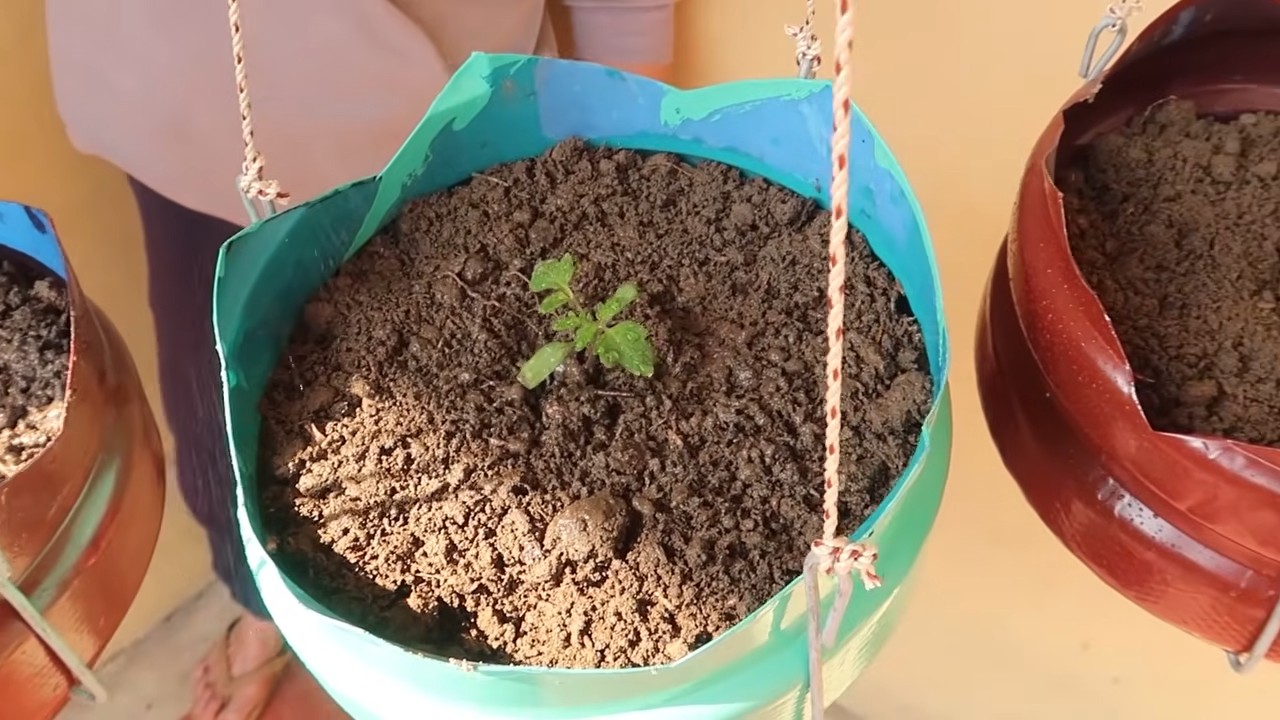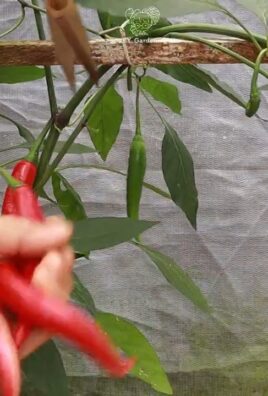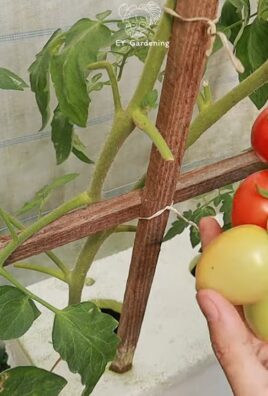Tomato harvest hack: Are you dreaming of a bountiful tomato harvest, overflowing with juicy, sun-ripened goodness? I know I am! But let’s be honest, sometimes getting those perfect tomatoes from vine to table can feel like a battle against time, pests, and the elements. We’ve all been there, watching our precious tomatoes crack, rot, or simply not ripen fast enough.
For centuries, gardeners have cherished the tomato, a fruit that journeyed from the Andes Mountains to become a global culinary staple. From Italian nonnas carefully tending their backyard vines to modern urban gardeners squeezing in a few plants on their balconies, the love for homegrown tomatoes is universal. But the challenge of maximizing your tomato harvest hack remains a constant.
That’s why I’m so excited to share this simple, yet incredibly effective DIY trick that will revolutionize your tomato harvesting game. This isn’t just about picking tomatoes; it’s about extending your harvest season, preventing waste, and enjoying the freshest, most flavorful tomatoes imaginable. If you’re tired of losing tomatoes to late blight, pests, or simply a lack of sunshine, then this is the hack you’ve been waiting for. Get ready to unlock the secrets to a truly abundant and rewarding tomato harvest!

Tomato Harvest Hack: Extend Your Tomato Season with This Simple Trick!
Hey fellow gardeners! Are you drowning in tomatoes right now? Or maybe your plants are slowing down, and you’re dreading the end of fresh tomato season? Well, I’ve got a fantastic hack for you that will let you enjoy homegrown tomatoes for weeks, maybe even months, longer! It’s all about ripening green tomatoes indoors, and trust me, it’s easier than you think.
This method is perfect if:
* You have a late-season frost threatening your crop.
* Your tomato plants are slowing down, and you want to get the most out of them.
* You simply want to extend your tomato enjoyment a little longer.
Let’s dive in!
What You’ll Need
Before we get started, gather these simple supplies:
* Green Tomatoes: Obviously! Choose tomatoes that are mature but still completely green. Avoid any with blemishes, bruises, or signs of disease.
* Cardboard Boxes or Trays: These will provide a dark, enclosed space for ripening. Shoeboxes, apple boxes, or even plastic trays lined with newspaper will work.
* Newspaper or Paper Towels: For wrapping and cushioning the tomatoes.
* A Cool, Dark Place: A basement, garage, or even a closet works well. The ideal temperature is between 55-70°F (13-21°C).
* Optional: Ethylene-Producing Fruit: A ripe banana or apple can speed up the ripening process.
Harvesting Your Green Tomatoes
The key to successful indoor ripening is to harvest your tomatoes at the right stage. You want them to be mature, meaning they’ve reached their full size and have a slightly waxy feel.
1. Choose Mature Green Tomatoes: Look for tomatoes that are firm and have a slight sheen. Gently squeeze them; they should feel solid, not soft or mushy.
2. Harvest Carefully: Use pruning shears or scissors to cut the tomato from the vine, leaving a small piece of the stem attached. This helps prevent rot.
3. Inspect for Damage: Discard any tomatoes with cracks, bruises, insect damage, or signs of disease. Only healthy tomatoes will ripen properly.
4. Handle Gently: Tomatoes bruise easily, so handle them with care during harvesting and storage.
The Wrapping Method: Individual Tomato Care
This method is a bit more time-consuming, but it can result in a more even ripening process and allows you to monitor each tomato individually.
1. Wrap Each Tomato: Take a sheet of newspaper or a paper towel and wrap each tomato individually. This helps to isolate them and prevent the spread of rot if one goes bad.
2. Place in a Box or Tray: Arrange the wrapped tomatoes in a single layer in your cardboard box or tray. Make sure they’re not touching each other to allow for good air circulation.
3. Add Ethylene-Producing Fruit (Optional): If you want to speed up the ripening process, place a ripe banana or apple in the box with the tomatoes. The ethylene gas they release will encourage ripening.
4. Store in a Cool, Dark Place: Place the box or tray in your cool, dark location. The ideal temperature is between 55-70°F (13-21°C).
5. Check Regularly: Check the tomatoes every few days for ripeness. Remove any that show signs of rot to prevent it from spreading to the others.
6. Enjoy When Ripe: Once a tomato has reached your desired level of ripeness, remove it from the box and enjoy!
The Layering Method: A Time-Saving Approach
This method is quicker and easier, but it requires a bit more attention to prevent rot.
1. Line Your Box or Tray: Line your cardboard box or tray with several layers of newspaper. This will help absorb any moisture and prevent the tomatoes from sitting in dampness.
2. Layer the Tomatoes: Place a layer of green tomatoes in the box, making sure they’re not touching each other too much.
3. Cover with Newspaper: Cover the first layer of tomatoes with another layer of newspaper.
4. Repeat Layers: Continue layering tomatoes and newspaper until the box is full, or you’ve used all your tomatoes.
5. Add Ethylene-Producing Fruit (Optional): As with the wrapping method, you can add a ripe banana or apple to the box to speed up ripening. Place it on top of the final layer of newspaper.
6. Store in a Cool, Dark Place: Place the box or tray in your cool, dark location.
7. Check Regularly: This is crucial with the layering method! Check the tomatoes every day or two for ripeness and signs of rot. Remove any rotten tomatoes immediately to prevent the spread of disease.
8. Enjoy When Ripe: Once a tomato has reached your desired level of ripeness, remove it from the box and enjoy!
The Hanging Method: For Whole Plants or Branches
If you have a whole tomato plant or large branches that you need to harvest before a frost, this method is for you.
1. Carefully Uproot or Cut: If you’re uprooting the entire plant, gently dig around the base and lift it out of the ground, trying to keep as much of the root system intact as possible. If you’re cutting branches, use pruning shears to make clean cuts.
2. Shake Off Excess Soil: Gently shake off any excess soil from the roots of the plant.
3. Hang Upside Down: Find a cool, dark, and dry place to hang the plant or branches. A garage, basement, or shed works well. Use twine or rope to tie the plant or branches upside down.
4. Monitor Ripening: Check the tomatoes regularly for ripeness. They will ripen slowly over time.
5. Harvest Ripe Tomatoes: As the tomatoes ripen, harvest them and enjoy!
Troubleshooting and Tips
Even with the best methods, things can sometimes go wrong. Here are a few common issues and how to address them:
* Tomatoes Rotting: This is usually caused by too much moisture or poor air circulation. Make sure your tomatoes are dry before storing them, and check them regularly for signs of rot. Remove any rotten tomatoes immediately.
* Tomatoes Not Ripening: This could be due to several factors, including temperature, maturity of the tomatoes, or lack of ethylene. Make sure your storage area is within the ideal temperature range (55-70°F or 13-21°C). You can also try adding a ripe banana or apple to the box to increase ethylene levels.
* Tomatoes Ripening Unevenly: This is common, especially with larger batches. Simply check the tomatoes regularly and remove them as they ripen.
* Flavor: Indoor-ripened tomatoes may not have the same intense flavor as vine-ripened tomatoes, but they’re still delicious! Try using them in cooked dishes or adding them to salads with other flavorful ingredients.
Maximizing Your Harvest: Beyond Ripening
While ripening green tomatoes indoors is a great way to extend your season, here are a few other tips to maximize your tomato harvest:
* Choose the Right Varieties: Some tomato varieties are better suited for indoor ripening than others. Look for varieties that are known for their good flavor and ability to ripen off the vine.
* Provide Adequate Support: Use stakes, cages, or trellises to support your tomato plants and prevent the fruit from touching the ground. This will help reduce the risk of rot and disease.
* Water Regularly: Water your tomato plants deeply and consistently, especially during hot, dry weather.
* Fertilize Properly: Use a balanced fertilizer to provide your tomato plants with the nutrients they need to produce a bountiful harvest.
* Prune Your Plants: Prune your tomato plants regularly to remove suckers and improve air circulation. This will help prevent disease and encourage fruit production.
* Protect from Pests and Diseases: Monitor your tomato plants regularly for pests and diseases. Take action quickly to control any problems that arise.
Enjoying Your Homegrown Tomatoes
Now that you’ve successfully ripened your green tomatoes indoors, it’s time to enjoy the fruits (or vegetables!) of your labor. Here are a few ideas:
* Salads: Add sliced tomatoes to your favorite salads for a burst of fresh flavor.
* Sandwiches: Use tomato slices on sandwiches, burgers, and wraps.
* Sauces: Make homemade tomato sauce, salsa, or chutney.
* Soups: Add diced tomatoes to soups and stews.
* Roasted Tomatoes: Roast tomatoes with herbs and garlic for a delicious side dish.
* Preserving: Can or freeze your tomatoes to enjoy them throughout the winter.
So there you have it! A simple and effective way to extend your tomato

Conclusion
So, there you have it! This simple, yet incredibly effective tomato harvest hack is more than just a time-saver; it’s a game-changer for anyone growing tomatoes, whether you’re a seasoned gardener or just starting out. Imagine spending less time painstakingly picking each tomato individually and more time enjoying the fruits (or vegetables!) of your labor. This method minimizes bruising, reduces the risk of damaging the plant, and allows you to harvest a large quantity of ripe tomatoes quickly and efficiently.
Why is this a must-try? Because it addresses the common frustrations of tomato harvesting: the time commitment, the potential for damage, and the sheer volume when your plants are producing at their peak. This hack streamlines the process, making it more manageable and enjoyable. Plus, it’s incredibly satisfying to see a basket overflowing with perfectly ripe tomatoes, all harvested with minimal effort.
But don’t just take our word for it! We encourage you to experiment with this tomato harvest hack and discover its benefits firsthand. Feel free to adapt the technique to suit your specific needs and preferences. For example, if you’re harvesting cherry tomatoes, you might find it easier to gently shake the entire truss into a large container. Or, if you’re dealing with particularly delicate heirloom varieties, you can use padded containers to prevent bruising.
Consider these variations to personalize your harvesting experience:
* Harvesting by ripeness stage: Use this method to harvest tomatoes at different stages of ripeness. You can separate them into batches for immediate use, canning, or ripening further indoors.
* Using different containers: Experiment with different types of containers, such as baskets, buckets, or even large bowls, to find what works best for you. Just make sure they are clean and food-safe.
* Harvesting in different weather conditions: While this method works well in most weather conditions, be extra careful when harvesting in wet or humid weather, as tomatoes are more susceptible to bruising when wet.
We’re confident that once you try this tomato harvest hack, you’ll wonder how you ever managed without it. It’s a simple, effective, and rewarding way to maximize your tomato harvest and enjoy the abundance of your garden.
Now, we want to hear from you! Have you tried this method before? What are your favorite tomato harvesting tips and tricks? Share your experiences and insights in the comments below. Let’s create a community of tomato-loving gardeners who are passionate about maximizing their harvests and enjoying the deliciousness of homegrown tomatoes. We are eager to learn from your experiences and see how you’ve adapted this hack to your own garden. Happy harvesting!
Frequently Asked Questions (FAQ)
Q: What types of tomatoes does this harvest hack work best for?
A: This tomato harvest hack is versatile and works well for most tomato varieties, including slicing tomatoes, Roma tomatoes, and even some larger heirloom varieties. However, it’s particularly effective for harvesting tomatoes that grow in clusters or trusses, as it allows you to harvest multiple tomatoes at once. For smaller cherry or grape tomatoes, a gentle shaking method might be more efficient. The key is to adjust your technique based on the size and type of tomato you’re harvesting.
Q: Will this method damage my tomato plants?
A: When done correctly, this tomato harvest hack should not damage your tomato plants. The key is to be gentle and avoid pulling or yanking on the plant. Use sharp, clean pruning shears or scissors to cut the stems cleanly, minimizing stress on the plant. If you’re harvesting a large cluster of tomatoes, support the weight of the cluster with your other hand to prevent the stem from breaking. Regularly inspect your plants for any signs of damage and address them promptly.
Q: What’s the best time of day to harvest tomatoes?
A: The best time to harvest tomatoes is typically in the morning, after the dew has dried but before the heat of the day sets in. Tomatoes harvested in the morning tend to be firmer and less susceptible to bruising. Avoid harvesting tomatoes in the heat of the day, as they can be more prone to damage and spoilage. If you must harvest in the afternoon, try to do so during the cooler hours.
Q: How do I store my harvested tomatoes?
A: The best way to store harvested tomatoes depends on their ripeness. Ripe tomatoes should be stored at room temperature, away from direct sunlight, for optimal flavor and texture. Avoid refrigerating ripe tomatoes, as this can cause them to become mealy and lose their flavor. Green or partially ripe tomatoes can be ripened indoors by placing them in a paper bag with an apple or banana. The ethylene gas released by these fruits will help to speed up the ripening process.
Q: Can I use this method for harvesting other vegetables?
A: While this tomato harvest hack is specifically designed for tomatoes, the general principle of cutting stems to harvest clusters of produce can be applied to other vegetables as well. For example, you can use a similar technique to harvest peppers, eggplants, or even some types of beans. The key is to adapt the method to the specific characteristics of the vegetable you’re harvesting.
Q: What if I don’t have pruning shears or scissors? Can I still use this method?
A: While pruning shears or scissors are the preferred tools for this method, you can still use it without them. However, it’s important to be extra careful to avoid damaging the plant. Instead of cutting the stems, you can gently twist and pull the tomatoes off the plant. Be sure to support the weight of the cluster with your other hand to prevent the stem from breaking. Keep in mind that this method may be more likely to cause damage to the plant, so it’s best to use pruning shears or scissors whenever possible.
Q: How do I know when my tomatoes are ripe enough to harvest?
A: The best way to determine if a tomato is ripe enough to harvest is to look for a deep, even color and a slight softness to the touch. The tomato should also easily detach from the plant with a gentle twist. Different tomato varieties will have different color characteristics when ripe, so it’s important to familiarize yourself with the specific variety you’re growing. You can also use a simple taste test to determine ripeness. A ripe tomato will have a sweet, slightly acidic flavor.
Q: What should I do with all the tomatoes I harvest?
A: The possibilities are endless! You can use your harvested tomatoes in a variety of dishes, such as salads, sauces, soups, and stews. You can also can or freeze them for later use. If you have a surplus of tomatoes, consider sharing them with friends, family, or neighbors. You can also donate them to a local food bank or soup kitchen. And of course, you can always enjoy them fresh off the vine!





Leave a Comment